Virtual tour of Karelian farmer’s homestead. Project description:
Website visitor makes a tour of a real Kizhi museum exhibition – The Homestead of a Karelian farmer Yakovlev. User can get general information about the house’s interiors and exteriors, it’s historical background, and the detailed information about all the exhibited items.
The tour can be made both of the straight route ("organized tour"), or by visiting the display points at random order ("free tour"). The entire tour consists of 18 display points, i. e. photos, mostly panoramic ones, displaying interiors and exteriors of the house, the barn and the bathhouse. Each photo includes information about all the main items represented on it. All the texts were written by Kizhi museum specialists.
The virtual house is inhabited by a big farmer’s family. Visitors will get acquainted with each family’s member. Together with them one can practice cooking of Karelian traditional meals, try washing in a "black" bathhouse, heated with a chimneyless stove, participate in soil cultivation and help solving farmer’s everyday problems.
A detailed illustration with original photos will help plunging into family members’ everyday life. The head of the family(‘bolshak’) Antropa, his wife Anna, daughters Marfa and Melanya, sons Yeremey and Martyn with Pelagea and Akulina - their wives, Anna and Maria – their young daughters, will acquaint you with the life of Karelians and their traditional occupations.
“Living” elements on the photos (birds, domestic animals, working clock, etc.) as well as interactive thematic games designed for visitors of all ages, make your tour more interesting. The tour is accompanied by informative comments of brownie Yasha (virtual tour guide).
Hint:
To view the Virtual tour you need to install Flash Player 9.0 or later.
The Virtual tour of Karelian farmer’s homestead project creators:
- Project initiator:
- Olga Titova.
- Photos by:
- Oleg Semenenko, Dmitry Bodyonov.
- Noteworthy pictures by:
- Elena Vostryakova, Serge Kasyanov.
- Music by:
- Polina Legkaya, Nadezhda Rigoeva, Evgeny Mikhailov, Natalia Mikhailova.
- Screen script and texts by:
- Trifonova Lyudmila, Irina nabokova, Svetlana Vorobyeva, Darya Abrosimova, Tina Dudinova, Margarita Vdovina, Elena Vostryakova, Dmitry Bodyonov, Pavel Shilov.
- Translated by:
- Nadezhda Medvedeva, Aleksey Isaev.
- Staging participants:
- Oleg Skobelev, Elena Gerasimova, Renata Gashkova, Evgeny Mikhailov, Lisa Mikhailova, Katya Mikhailova, Roman Martyanov, Masha Martyanova, Polina Legkaya, Nadezhda Rigoeva, Boris Moskin, Evgeniya Matasova, Vladlena kantor, Lisa Gurbaeva.
- Web realization:
- Dmitry Bodyonov, Pavel Shilov, Serge Grin.
Summary:
Panorama of the whole homestead
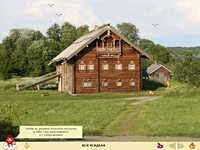
The exhibition of Karelian culture in the “Kizhi” museum is located on the eastern shore of the island near the Dudkin Navolok peninsula. The Karelians are among the aboriginal peoples who inhabited Karelia in pre-Christian times. The Karelian section of the museum represents the culture of Livvik-Karelians from Pryazha region located in the south of Karelia. This is a replica of a farmstead of the late XIX – early XX cc. The core of this farmstead is the house of farmer Yakovlev built in the village of Klescheila in the 1880 – 90s by a team of local carpenters and the owner, Maxim Yakovlev personally. The Yakovlevs were a family of 15 people. They owned a prosperous farm with 13 ha of plough-land, 10 cows, 5 horses, and 25 sheep. In addition to the house, Yakovlev’s farmstead on the original place included a two-storey granary, a stable, a sauna heated with a chimneyless stove. More than that, the Yakovlevs’ owned a water mill and creamer that brought a good income. Yakovlev’s house was transferred to the “Kizhi” museum and restored in 1966.
By the house porch
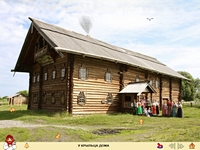
Yakovlev’s house is a traditional house of a northern farmer with the living and household parts located under one roof. The house of this type was common in South Karelia in the late XIX – early XX cc. Traditional architectural features of Karelian houses are asymmetrically arranged log walls separating living room from guest room, and a continuous-solid logwork of shed made single for the upper and lower floors. This is what makes the house of Yakovlev distinct from the traditional Russian Zaonezhye homes, where the shed (the second floor of the household part) is supported by free-standing pillars ‘bulls’.
Living room for winter
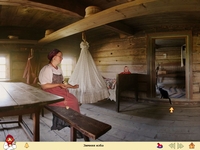
The logs were left round intact from the outside, while the walls inside were neatly hewn and adzed. These logs were quite often rounded in the corners to protect from cold in winter. The size of the living room was conditioned by the size of the logs. Living room of the Karelians is deeply archaic and features many elements of traditional interior. At first sight, it seems to be a small difference in dwelling between a Russian and Karelian farmer, but still such a difference actually exists. The stove is located to the left of the entrance with its mouth directed to the sidewall according to Karelian customs. God's (Holy) corner is placed diagonally to the stove. The Karelians always placed their samovars under the icons to show their prosperity. a massive pole is found near the stove, and two shelves for clean dishes and baked goods run at right angles to this pole. Broad benches stretch along the walls and, shelves above them. The table is set in the central portion of the living room, which is in line with the Baltic-Finnish traditions. There is a washstand aside from the door according to the customs of the Karelians from Pryazha District; close to it, a Karelian nest of shelves ‘rundugu’ is located, and this one was used for bowls and pots with milk for souring. There is not much movable furniture: a table equipped with a hencoop, suspended cradle, and wooden bed. Containers made of birch bark are very traditional Karelian items as well as the furniture made of parts of tree left intact in their natural form and a lot of chiseled and carved dishes.
Guest room downstairs
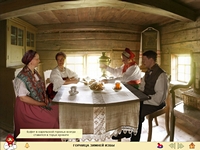
Meanwhile the interior of a living room for winter strictly follows traditions, a guest room downstairs is closer to a typical urban interior with a sliding table, cupboard for festive dishes, and wooden sofa with a backrest of thin balusters. Bed place is hidden with a printed cotton curtain. The guest room was heated by the stove addition. The interior reflects urban culture of the late XIX – early XX cc.
Summer living room
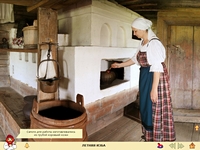
The upper living room is very similar in the arrangement to the living room downstairs. The windows in the summer living room are bigger making the room lighter, more solemn and the room looks more spacious than the winter living room. From the window, there is a wonderful view of the Kizhi churches, the lake and a running picturesque path.
Ladder of the summer living room

The peasants had many different utensils and facilities for their storage. Upstairs there is another ladder near a living room. Here, on the benches are common for Southern Karelia wooden pails with handles made of birch bark or iron. Fish tackle is hung over a wall. Very often in the warm weather the ladder was used as an additional summer bedroom. They brought in a mattress stuffed with aromatic hay, leaves and herbs. Sleeping in this kind of bed was like sleeping in the hayloft with exciting and cheering scent of cut grass. Sleep in this bed was deep and sound while awaking was easy and fresh.
Shed
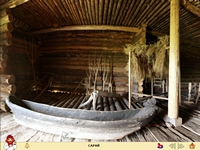
The shed of Yakovlev’s house is upstairs: a horse with a load could get there by a ramp made of logs. Thanks to the size of the shed it was possible to store a lot of hay, sleds and boats. The tools and implements exhibited here show the occupations of the Karelian peasants. Here there is a collection of ploughs, hoes, sickles, hand mills, carpenter’s tools, traps, tackle, and tools to work with flax. The floor of the shed is made of thick boards which still have the marks of an axe. There was no ceiling in the shed but in one part of it, at the height of three meters from the floor, they fixed several logs and covered them with boards or poles. This platform was for storing hay.
By the house ramp
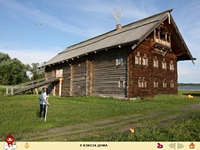
Ramp runs into the household part of a house. Ramp is a wide gently sloping flooring of logs. Horse could bring a hay cart by this ramp to the shed; painted sledges could just as well climb by this ramp. Horse was unharnessed and brought to the stables on the lower floor; sledges were left on the upper floor. Looking at the house we may imagine how spacious it is and how much material was spend for its construction. It was critical for the inhabitants of this house to keep it warm and this was much conditioned on the methods and quality of notching corners. This is why carpenters were notching the corners with their ends protruding from the walls (old method called "v oblo"). Actually, carpenters had to know their trade to a nicety. for example, grooves on the surface of the upper logs in the wall were cut rounded but not triangular to prevent splitting. The width of this groove was also of great importance: on the one hand, the wider the groove, the warmer the house and, on the other hand, the wider the groove, the lower the row of logs, and more material is needed for construction.
Sauna
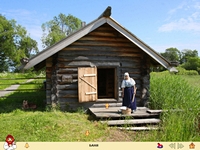
In old times laundering was not so easy. The peasants used ash instead if soap powder. Instead of laundry machine they used a tub where they put clothes together with a pouch of sifted ash and filled the tub with cold water. Then they put heated rocks to make the water boil. After boiling the clothes were bashed with a paddle on a boardwalk to get rid of remaining dirt and then rinsed. The southern Karelians first of all rinsed tablecloths and towels.
Interior of the sauna
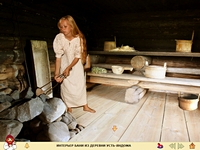
In the 19th century the water was heated traditionally – by tonging red hot rocks and putting them into the barrel filled with cold water. In the 20th century they began to heat water in large cast-iron cauldrons clayed into the primitive stove. The Karelians considered sauna procedures to increase young girls’ attractiveness (their “lembi’). to increase her “lembi” a girl was to apply magic twigs of birch, mountain ash and alder steaming in the sauna or she was to squeeze herself through a mountain ash hoop. The sauna was a very important element in the wedding rituals. When the clean water was poured over a bride at the end of her bathing in the sauna she was to stand on a pan as the magic power of iron protected her against the evil. After bathing she was clad with a shirt of her bridegroom so that she would be better loved than ever. a sauna that was built apart suited very well to the childbirth. The mother with a baby stayed in the sauna for several days under a midwife’s care.
Granary
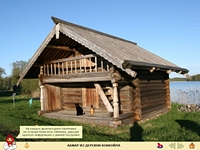
A two-storey granary near the house of Yakovlev was brought from the Karelian village of Kokkoyla. It was built by peasant Kiprushkin in 1892. The granary has a gable roof made with no nails. The gallery with the entrance on the second floor typical of Karelians is under the slope. a platform used for unloading grain is located in front of the entrance door. Decorative elements feature some national characteristics.
Interior of the granary
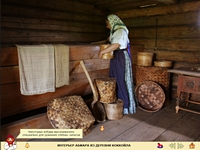
Granaries were the most important of all the surrounding buildings within the farmstead. Depending on the major occupations of owners, they had a different purpose: for storage of grain, fish and fishing tackles, farming utensils, tools, clothes, and other belongings. Interior of the granary was always simple and subordinated to the needs of the owner. Big bins fixed in the logs were set on the ground floor along the walls. They were cut from large wooden plates in the form of a chest, divided internally by transverse bulkheads. Each compartment was designed so that the grain taken in the lower drawer was replaced with the same amount from the bin. Most often, the bins were located opposite the entrance, sometimes running along the sidewalls, forming a narrow passageway in the center. Such bins were necessarily covered with the lid to protect the grain from excess moisture and litter. Flour was stored in specially prepared compartments, or in barrels. Some of the owners, placed stones smoked in the home oven alongside with the flour to protect stocks from the mold and bugs (2-3 stones per two sacks of flour). Here were dairy products, bags of grains, the barrels of salted fish, pickled berries. Property that is more valuable was kept on the second floor. In the cross walls of this building, sometimes wooden hangers, or racks were fixed. They were used for hanging clothing, nets and fishing gear, harness, skins, leather, yarn. Along the wall, large longitudinal shelves for small items were set, or these could have been chests as well. Some granaries were built specifically for the storage of grain stocks. According to the stories of peasants, they stored raw rye on the first floor, and the second floor was the storage of flour.
